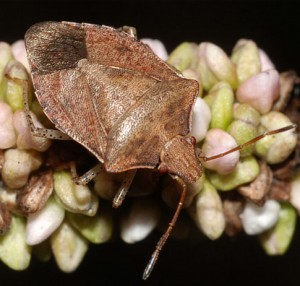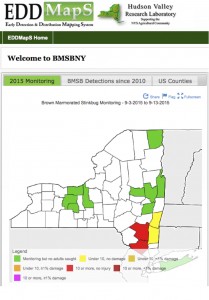
The adult brown stink bug, Euschistus servus (Say) however, tends to live along the orchard edge, utilizing broad leaf mullen and pigweed species, feeding on flowers, stems and plant foliage. As these plants mature stink bug feed on the seed, nut or fruit, making them important pests of many crops.
There is no distinction or visible difference in feeding injury on fruit caused by various stink bug species. During the 2015 drought occurring in July to the 2nd week of August, both green stink bug and BMSB observed in peach and apple. Unlike the native stink bug species, BMSB migration is more sporadic, with ‘waves’ of the insect continuing to migrate into the orchard during late harvest.

Euschistus servus on Persicaria maculosa, or lady’s thumb on roadside in oak woods.
Image credit : Thomas Palmer
Tisbury, Dukes County, Massachusetts, USA
We are now seeing BMSB migration into tree fruit with adult trap numbers above threshold in a number of orchards where the insect is being monitored (see EDDMaps below). At this point we are not certain if the damage we are now seeing was brought about by the July Drought or the low population of BMSB during the late season migration. In either situation, management of SB should continue in Ulster and Orange Counties where trap numbers exceed 10 adult per tap per week. The situation will worsen if drought conditions begin again through late October.
In orchards where BMSB are monitored AND effective insecticide applications are being made, drop in the trap captures have been observed over the past two weeks but threshold in some managed blocks continue to require weekly applications.
Continued applications for BMSB management are recommended in blocks with BMSB that exceed threshold. By targeting the orchard blocks that have wooded border first, growers should consider spraying from the perimeter of the orchard into the block (a border application). As the concentration of injury will occur within 90′ along the wooded boarders, concentrating your efforts along the edge would be an economical and viable option for management of the BMSB at this time. If BMSB adults are found within the orchard, then alternate row middle or whole orchard applications will likely be required.
At risk are the NY counties of Dutchess, Orange, Ulster and Columbia. Scouting in Red Delicious, Golden Delicious, Honeycrisp, Ruby Frost and Pink Lady should be ongoing through harvest. Thus far, the red delicious appear to have suffered the largest losses from SB feeding injury.
If Bifenthrin has not yet been employed in your orchard (having a 30 re-treatment restriction) AND you have the ability to use it on susceptible varieties nearing harvest (14d PHI), then it would be the best option at this point in time.

The list of the most effective insecticides for BMSB management is found above. NYS labeled insecticides effective for use against the BMSB are available in four major classes including pre-mix formulations. Danitol is likely to be the best choice during the latter part of the season as its short pre-harvest interval and efficacy is a good fit. It is not as effective as Bifenthrin, however, it’s a very good choice for management of BMSB in peach as it has a 3-day PHI, strong efficacy, especially as a knock down insecticide, and also works well against the native stink bugs.
New York’s Section 18 application for the use of products containing bifenthrin has recently been approved by the EPA to control brown marmorated stink bug (BMSB). This is a renewal by the EPA and NYS DEC of a ‘Section 18 Emergency/Crisis Exemption Approval’ use permit for the pyrethroid bifenthrin to control brown marmorated stink bug on apples, peaches, and nectarines this year. Comparative efficacy studies in the lab and field have shown bifenthrin to be one of the most effective insecticides available against BMSB for use in NY State. Although this is an important tool for management of BMSB, the residual against this pest is relatively short lived, requiring vigilance in trapping and scouting 4 days post application.
In NYS its use is limited to Columbia, Dutchess, Orange and Ulster Counties.
Bifenthrin is a pyrethroid sold under the trade names of Brigade WSB (10% bifenthrin, EPA Reg. No. 279-3108, FMC Corp.), Bifenture EC (25% bifenthrin, EPA Reg. No. 70506-227), and Bifenture 10DF (10% bifenthrin, EPA Reg. No. 70506-227, United Phosphorus Inc.).
Labels specific for the Section 18 Exemption for bifenthrin use in NY can be found here:
Brigade WSB
Bifenture EC
Bifenture 10DF
Regardless of the product used, a maximum of 0.08 to 0.2 lb[AI]/acre/season will be allowed, with no more than 0.5 lb a.i./acre applied per year with multiple applications made at a minimum of 30 day intervals; a restricted entry interval (REI) of 12 hours and pre-harvest interval (PHI) of 14 days must be observed. When applying either of these materials for BMSB control on apples, peaches, or nectarines, growers must have possession of the Section 18 label.


